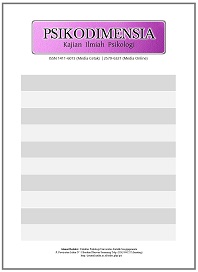Studi Pendahuluan: Gambaran Dukungan Sosial dan Dampak Gejala Fibromyalgia pada Kualitas Hidup Penyintas Sindrom Fibromyalgia di Indonesia
Abstract
Penelitian ini mengukur bagaimana gejala fibromyalgia memengaruhi kehidupan sehari-hari penyintas, serta menggambarkan dukungan sosial yang tersedia dan dampak gejala pada kualitas hidup penyintas fibromyalgia di Indonesia. Nyeri pada fibromyalgia didefinisikan sebagai nyeri yang menyebar, persisten, dan sensasi terbakar yang intens; mengakibatkan pengurangan kemampuan fungsional, berubah seiring waktu, dan dipersepsikan secara berbeda oleh setiap individu (Biccheri et al., 2016). Partisipan berjumlah 17 orang berusia 23-71 tahun. Hasil penelitian menunjukkan bahwa rata-rata dampak gejala pada kualitas hidup yang dialami oleh partisipan penelitian termasuk dalam kategori sedang (M=113.82), dan rata-rata penyintas memiliki dukungan sosial yang sedang (M=65.76) serta jumlah kerabat dekat sedikit (M=5.18). Penelitian lanjutan perlu dilakukan untuk mengidentifikasi aspek kepercayaan kepada orang terdekat yang berperan dalam dukungan sosial penyintas. Kualitas hidup perlu difokuskan sebagai masalah psikososial yang paling menonjol pada kesehatan penyintas.
Keywords
Full Text:
PDF (Bahasa Indonesia)References
Afiyanti, Y., & Maternitas Fakultas Ilmu Keperawatan, K. (n.d.). ANALISIS KONSEP KUALITAS HIDUP.
Bellato, E., Marini, E., Castoldi, F., Barbasetti, N., Mattei, L., Bonasia, D. E., & Blonna, D. (2012). Fibromyalgia syndrome: Etiology, pathogenesis, diagnosis, and treatment. In Pain Research and Treatment (Vol. 2012). https://doi.org/10.1155/2012/426130
Bennett, R. M., Friend, R., Jones, K. D., Ward, R., Han, B. K., & Ross, R. L. (2009). The revised fibromyalgia impact questionnaire (FIQR): Validation and psychometric properties. Arthritis Research and Therapy, 11(4). https://doi.org/10.1186/ar2783
Biccheri, E., Roussiau, N., & Mambet-Doué, C. (2016). Fibromyalgia, Spirituality, Coping and Quality of Life. Journal of Religion and Health, 55(4), 1189–1197. https://doi.org/10.1007/s10943-016-0216-9
Cahuas, A., Marenus, M. W., Kumaravel, V., Murray, A., Friedman, K., Ottensoser, H., & Chen, W. (2023). Perceived social support and COVID-19 impact on quality of life in college students: an observational study. Annals of Medicine, 55(1), 136–145. https://doi.org/10.1080/07853890.2022.2154943
Centers for Disease Control and Prevention. (2020, January). Fibromyalgia. Centers for Disease Control and Prevention. https://www.cdc.gov/arthritis/basics/fibromyalgia.htm
Chaturvedi, S. K., & Muliyala, K. P. (2016). The Meaning in Quality of Life. In Journal of Psychosocial Rehabilitation and Mental Health (Vol. 3, Issue 2, pp. 47–49). Springer. https://doi.org/10.1007/s40737-016-0069-2
Choy, E. (2015). Fibromyalgia Syndrome.
Cohen, S. (1993). Social Relationships and Health.
Creswell, J. W., & Clark, V. L. P. (2018). Mendesain dan Melaksanakan Mixed Methods Research (Edisi 2).
Dellwo, A. (2022). Fibromyalgia: Symptoms and Complications. https://www.verywellhealth.com/fibromyalgia-symptoms-716139
Diener, E. (2000). Subjective well-being: The science of happiness and a proposal for a national index. American Psychologist, 55(1), 34–43. https://doi.org/10.1037/0003-066X.55.1.34
Galvez-Sánchez, C. M., Duschek, S., & del Paso, G. A. R. (2019). Psychological impact of fibromyalgia: Current perspectives. In Psychology Research and Behavior Management (Vol. 12, pp. 117–127). Dove Medical Press Ltd. https://doi.org/10.2147/PRBM.S178240
Häuser, W., Ablin, J., Fitzcharles, M. A., Littlejohn, G., Luciano, J. v., Usui, C., & Walitt, B. (2015). Fibromyalgia. Nature Reviews Disease Primers, 1. https://doi.org/10.1038/nrdp.2015.22
Higuera, V. (2020, January 8). Fibromyalgia: Real or imagined? https://www.healthline.com/health/fibromyalgia-real-or-imagined#symptoms
Jahan, F., Nanji, K., Qidwai, W., & Qasim, R. (2012). Chronic pain - Is it a public health problem? Oman Medical Journal, 27(3), 192–195. https://doi.org/10.5001/omj.2012.44
Jay, G. W., & Barkin, R. L. (2015). Fibromyalgia. In Disease-a-Month (Vol. 61, Issue 3, pp. 66–111). Mosby Inc. https://doi.org/10.1016/j.disamonth.2015.01.002
Jones, K. D., Horak, F. B., Winters-Stone, K., Irvine, J. M., & Bennett, R. M. (2009). Fibromyalgia is associated with impaired balance and falls. Journal of Clinical Rheumatology, 15(1), 16–21. https://doi.org/10.1097/RHU.0b013e318190f991
Kasprzak, E. (2011). Perceived social support and life-satisfaction. Polish Psychological Bulletin, 41(4), 144–154. https://doi.org/10.2478/v10059-010-0019-x
Kaushansky, D., Cox, J., Dodson, C., McNeeley, M., Kumar, S., & Iverson, E. (2017). Living a secret: Disclosure among adolescents and young adults with chronic illnesses. Chronic Illness, 13(1), 49–61. https://doi.org/10.1177/1742395316655855
Mansfield, K. E., Sim, J., Croft, P., & Jordan, K. P. (2017). Identifying patients with chronic widespread pain in primary care. Pain, 158(1), 110–119. https://doi.org/10.1097/j.pain.0000000000000733
Moghadam, K., Mansour-Ghanaei, R., Esmaeilpour-Bandboni, M., & Atrkar-Roshan, Z. (2020). Investigating the relationship between social support and quality of life in the elderly. Journal of Education and Health Promotion, 9(1). https://doi.org/10.4103/jehp.jehp_149_20
National Health Service. (n.d.). Myalgic Encephalomyelitis or Chronic Fatigue Syndrome (ME/CFS). Retrieved January 8, 2020, from https://www.nhs.uk/conditions/chronic-fatigue-syndrome-cfs/symptoms/
National Institute of Arthritis and Musculoskeletal and Skin Diseases. (2021). Overview of Fibromyalgia. https://www.niams.nih.gov/health-topics/fibromyalgia
Nusrat, M. (2009, November 3). Fibromyalgia, penderita di Indonesia tertinggi. https://nasional.kompas.com/read/2009/11/03/0243161/Fibromyalgia.Penderita.di.Indonesia.Tertinggi?page=all#page1
Pérez-De-Heredia-Torres, M., Huertas-Hoyas, E., Martínez-Piédrola, R., Palacios-Ceña, D., Alegre-Ayala, J., Santamaría-Vázquez, M., & Fernández-De-Las-Peñas, C. (2017). Balance deficiencies in women with fibromyalgia assessed using computerised dynamic posturography: A cross-sectional study in Spain. BMJ Open, 7(7). https://doi.org/10.1136/bmjopen-2017-016239
Purwata, T. E. (2014). Diagnosis dan manajemen fibromialgia.
Russell, D., Álvarez Gallardo, I. C., Wilson, I., Hughes, C. M., Davison, G. W., Sañudo, B., & McVeigh, J. G. (2018). ‘Exercise to me is a scary word’: perceptions of fatigue, sleep dysfunction, and exercise in people with fibromyalgia syndrome—a focus group study. Rheumatology International, 38(3), 507–515. https://doi.org/10.1007/s00296-018-3932-5
Sarafino, E. P., & Smith, T. W. (2017). Health psychology: Biopsychosocial interactions (9th ed.) (9th ed.). Wiley.
Shabahang, R., Sheykhangafshe, F. B., Aruguete, M. S., & Hossienkhanzadeh, A. A. (2020). Beliefs about sharing illness experiences in chronic fatigue syndrome: The role of interpersonal trust and personality. Health Psychology Report, 8(4), 435–444. https://doi.org/10.5114/hpr.2020.99395
Sherbourne, C. D., & Stewart, A. L. (1991). THE MOS SOCIAL SUPPORT SURVEY. In Sot. Sci. Med (Vol. 32, Issue 6).
Shuster, J., Mccormack Ba, J., Riddell, R. P., & Toplak, M. E. (2009). Understanding the psychosocial profile of women with fibromyalgia syndrome. Pain Res Manage, 14(3).
Sivan, M., Phillips, M., Baguley, I. J., & Nott, M. (2019). Oxford handbook of rehabilitation medicine (3rd ed.).
Thoits, P. A. (1995). Extra Issue: Forty Years of Medical Sociology: The State of the Art and Directions for the. In Source: Journal of Health and Social Behavior (Vol. 35).
Thoits, P. A. (2011). Mechanisms linking social ties and support to physical and mental health. Journal of Health and Social Behavior, 52(2), 145–161. https://doi.org/10.1177/0022146510395592
Wolfe, F., Clauw, D. J., Fitzcharles, M. A., Goldenberg, D. L., Katz, R. S., Mease, P., Russell, A. S., Russell, I. J., Winfield, J. B., & Yunus, M. B. (2010). The American College of Rheumatology preliminary diagnostic criteria for fibromyalgia and measurement of symptom severity. Arthritis Care and Research, 62(5), 600–610. https://doi.org/10.1002/acr.20140
Wolfe, F., Smythe, H. A., Yunus, M. B., Bennett, R. M., Bombardier, C., Goldenberg, D. L., Tugwell, P., Campbell, S. M., Abeles, M., Clark, P., Fam, A. G., Farber, S. J., Fiechtner, J. J., Michael Franklin, C., Gatter, R. A., Hamaty, D., Lessard, J., Lichtbroun, A. S., Masi, A. T., … West-ern Hospital, T. (1990). THE AMERICAN COLLEGE OF RHEUMATOLOGY 1990 CRITERIA FOR THE CLASSIFICATION OF FIBROMYALGIA Report of the Multicenter Criteria Committee.
World Health Organization. (1998). WHOQOL user manual: Programme on mental health. World Health Organization.
Wroe, A. L., & Bowers, H. M. (2019). Beliefs about sharing illness experiences: Development of a scale and relationship with symptoms of fibromyalgia. British Journal of Health Psychology, 24(3), 687–703. https://doi.org/10.1111/bjhp.12376
DOI: https://doi.org/10.24167/psidim.v22i1.10120
Print ISSN : 1411-6073 | online ISSN : 2579-6321 View My Stats

This work is licensed under a Creative Commons Attribution 4.0 International License.




















